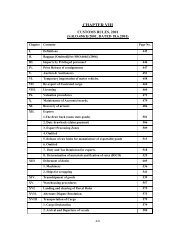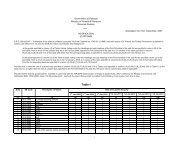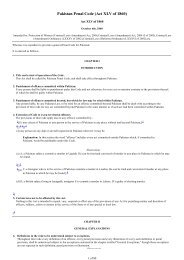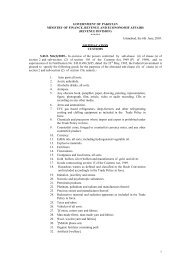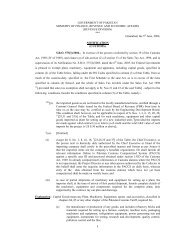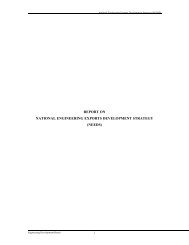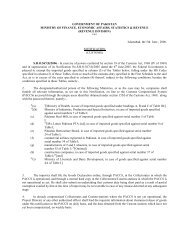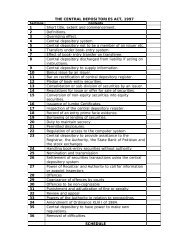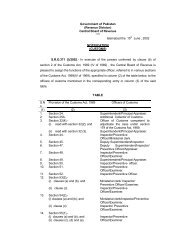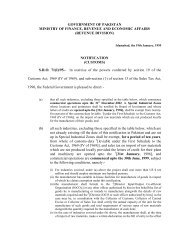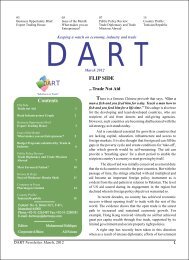47. Pakistan Economic Survey 2011-12 - Consultancy Services in ...
47. Pakistan Economic Survey 2011-12 - Consultancy Services in ...
47. Pakistan Economic Survey 2011-12 - Consultancy Services in ...
Create successful ePaper yourself
Turn your PDF publications into a flip-book with our unique Google optimized e-Paper software.
Public DebtEDL to rema<strong>in</strong> below 2 times of FEE.Improvement was observed <strong>in</strong> the EDL-to-FEEratio, which was 1.3 <strong>in</strong> fiscal year <strong>2011</strong> comparedto 1.5 <strong>in</strong> fiscal year 2010 at the back of strongworkers’ remittances and a positive turn-around <strong>in</strong>export earn<strong>in</strong>gs. The improvement of this ratiosuggests that <strong>Pakistan</strong>’s stock of external debt andliabilities is grow<strong>in</strong>g at a slower rate than itsforeign exchange earn<strong>in</strong>gs. Dur<strong>in</strong>g July-March20<strong>12</strong>, the ratio stood at 1.7aga<strong>in</strong>st 1.3 dur<strong>in</strong>g thesame period last year.Table-9.8 External Debt Susta<strong>in</strong>ability(<strong>in</strong> percent)External Debt Indicators 2007 2008 2009 2010 <strong>2011</strong> 20<strong>12</strong>*Non Interest Current Account/GDP -3.8 -7.1 -4.5 -1.4 0.8 -1.2EDL/FEE (times) 1.2 1.2 1.5 1.5 1.3 1.7EDL/FER 2.5 4.0 4.2 3.3 3.3 3.6EDL/GDP 28.3 28.2 32.3 31.5 28.5 26.5EDL Servic<strong>in</strong>g/FEE <strong>12</strong>.6 11.7 18.0 16.5 11.4 10.0STD/EDL 0.1 2.4 2.8 1.4 1.0 0.9Source: EAD, SBP & Debt Policy Coord<strong>in</strong>ation Office* July - March 20<strong>12</strong>FEE: Foreign Exchange Earn<strong>in</strong>gs; STD: Short-term Debt; EDL: External Debt and Liabilities; FER: ForeignExchange ReservesA decrease <strong>in</strong> EDL <strong>in</strong> relations to ForeignExchange Reserves reflects the consolidation offoreign exchange reserves and a generalimprovement of the country’s repayment capacityor vice versa. On the onset of SBA <strong>in</strong> 2008, theratio decl<strong>in</strong>ed to 3.3 <strong>in</strong> 2009-10 as EDL growthslowed and foreign exchange reserves shored up.The ratio did not improve <strong>in</strong> fiscal year <strong>2011</strong>ma<strong>in</strong>ly because of stagnation <strong>in</strong> reserves and lowergrowth <strong>in</strong> EDL stock. By end-March 20<strong>12</strong>, theratio deteriorated slightly to 3.6 compared to 3.3 byend June 20<strong>12</strong> ma<strong>in</strong>ly because of drawdown onreserves ow<strong>in</strong>g to lower Foreign DirectInvestments and other non-debt creat<strong>in</strong>g flows.A major improvement has been witnessed <strong>in</strong> EDLto-GDPratio as it improves from 31.5 percent <strong>in</strong>fiscal year 2010 to 28.5 percent <strong>in</strong> fiscal year <strong>2011</strong>.By end-March 20<strong>12</strong>, EDL as a percent of GDPstood at 26.5 percent, thereby show<strong>in</strong>g a decreaseof 2.0 percentage po<strong>in</strong>ts <strong>in</strong> first n<strong>in</strong>e month ofcurrent fiscal year. This improvement is ma<strong>in</strong>lydue to faster growth <strong>in</strong> nom<strong>in</strong>al GDP <strong>in</strong> relation toslower growth <strong>in</strong> external debt ow<strong>in</strong>g to lowerf<strong>in</strong>anc<strong>in</strong>g from external sources.External Debt Servic<strong>in</strong>g as a percentage of ForeignExchange Earn<strong>in</strong>gs has been decl<strong>in</strong><strong>in</strong>g s<strong>in</strong>ce fiscalyear 2010 and stood at 11.4 percent dur<strong>in</strong>g fiscalyear <strong>2011</strong> ow<strong>in</strong>g to strong workers’ remittancesand a positive turn-around <strong>in</strong> export earn<strong>in</strong>gs. Agenerally acceptable threshold requires a country’sEDL servic<strong>in</strong>g to rema<strong>in</strong> below 20 percent of FEE.The current levels of servic<strong>in</strong>g are bound to<strong>in</strong>crease as IMF-SBA repayments <strong>in</strong>itiate <strong>in</strong> fiscalyear 20<strong>12</strong>, that require serious efforts to enhancethe export earn<strong>in</strong>gs.<strong>Pakistan</strong>’s level of Short Term Debt (STD) as apercentage of EDL has historically been lower thanmost other develop<strong>in</strong>g countries. It was just 0.1percent <strong>in</strong> 2006-07. Fiscal year 2009-10 has seenan improvement <strong>in</strong> STD as a percentage of EDL to1.4 percent which decreased to 1 percent <strong>in</strong> fiscalyear 2010-11. Dur<strong>in</strong>g July-March 20<strong>12</strong>, the ratiostood at 0.9 percent.9.5 <strong>Pakistan</strong>’s L<strong>in</strong>k with International CapitalMarketThe first ten months of the current f<strong>in</strong>ancial yearwitnessed a period of substantial volatility <strong>in</strong> theglobal markets, largely as a consequence of fearsrelat<strong>in</strong>g to the Eurozone’s peripheral economies.The Emerg<strong>in</strong>g Market Bond Index (“EMBI”), abenchmark <strong>in</strong>dex for measur<strong>in</strong>g the total returnperformance of <strong>in</strong>ternational government bondsissued by emerg<strong>in</strong>g market countries, has depictedan <strong>in</strong>crease over June <strong>2011</strong> levels, imply<strong>in</strong>g an<strong>in</strong>crease <strong>in</strong> costs for tapp<strong>in</strong>g <strong>in</strong>ternational debt135



